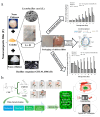Delivery of Probiotics with Cellulose-Based Films and Their Food Applications
- PMID: 38543398
- PMCID: PMC10976014
- DOI: 10.3390/polym16060794
Delivery of Probiotics with Cellulose-Based Films and Their Food Applications
Abstract
Probiotics have attracted great interest from many researchers due to their beneficial effects. Encapsulation of probiotics into biopolymer matrices has led to the development of active food packaging materials as an alternative to traditional ones for controlling food-borne microorganisms, extending food shelf life, improving food safety, and achieving health-promoting effects. The challenges of low survival rates during processing, storage, and delivery to the gut and low intestinal colonization, storage stability, and controllability have greatly limited the use of probiotics in practical food-preservation applications. The encapsulation of probiotics with a protective matrix can increase their resistance to a harsh environment and improve their survival rates, making probiotics appropriate in the food packaging field. Cellulose has attracted extensive attention in food packaging due to its excellent biocompatibility, biodegradability, environmental friendliness, renewability, and excellent mechanical strength. In this review, we provide a brief overview of the main types of cellulose used for probiotic encapsulation, as well as the current advances in different probiotic encapsulating strategies with cellulose, grafted cellulose, and cellulose-derived materials, including electrospinning, cross-linking, in-situ growth, casting strategies, and their combinations. The effect of cellulose encapsulation on the survival rate of probiotics and the patented encapsulated probiotics are also introduced. In addition, applications of cellulose-encapsulated probiotics in the food industry are also briefly discussed. Finally, the future trends toward developing encapsulated probiotics with improved health benefits and advanced features with cellulose-based materials are discussed.
Keywords: cellulose; encapsulation; food application; probiotic.
Conflict of interest statement
The authors declare no conflict of interest.
Figures








Similar articles
-
Intestinal Delivery of Probiotics: Materials, Strategies, and Applications.Adv Mater. 2024 Aug;36(32):e2310174. doi: 10.1002/adma.202310174. Epub 2024 Jun 4. Adv Mater. 2024. PMID: 38245861 Review.
-
Biopolymer encapsulation for improved probiotic delivery: Advancements and challenges.AIMS Microbiol. 2024 Nov 15;10(4):986-1023. doi: 10.3934/microbiol.2024043. eCollection 2024. AIMS Microbiol. 2024. PMID: 39628726 Free PMC article. Review.
-
Novel nano-encapsulated probiotic agents: Encapsulate materials, delivery, and encapsulation systems.J Control Release. 2022 Sep;349:184-205. doi: 10.1016/j.jconrel.2022.06.061. Epub 2022 Jul 8. J Control Release. 2022. PMID: 35798093 Review.
-
Natural sources and encapsulating materials for probiotics delivery systems: Recent applications and challenges in functional food development.Front Nutr. 2022 Sep 21;9:971784. doi: 10.3389/fnut.2022.971784. eCollection 2022. Front Nutr. 2022. PMID: 36211518 Free PMC article. Review.
-
Functionalizing and bio-preserving processed food products via probiotic and synbiotic edible films and coatings.Adv Food Nutr Res. 2020;94:161-221. doi: 10.1016/bs.afnr.2020.06.004. Epub 2020 Jul 14. Adv Food Nutr Res. 2020. PMID: 32892833
Cited by
-
Plant cell-inspired colon-targeted cargo delivery systems with dual-triggered release mechanisms.Sci Adv. 2025 May 16;11(20):eadt2653. doi: 10.1126/sciadv.adt2653. Epub 2025 May 14. Sci Adv. 2025. PMID: 40367175 Free PMC article.
-
Advances in Cellulose-Based Hydrogels: Current Trends and Challenges.Gels. 2024 Dec 20;10(12):842. doi: 10.3390/gels10120842. Gels. 2024. PMID: 39727599 Free PMC article. Review.
-
Design and Fabrication of Sustained Bacterial Release Scaffolds to Support the Microbiome.Pharmaceutics. 2024 Aug 14;16(8):1066. doi: 10.3390/pharmaceutics16081066. Pharmaceutics. 2024. PMID: 39204410 Free PMC article.
-
3D printed spiral tube-like cellulose scaffold for oral delivery of probiotics.Sci Adv. 2024 Aug 23;10(34):eadp3654. doi: 10.1126/sciadv.adp3654. Epub 2024 Aug 23. Sci Adv. 2024. PMID: 39178258 Free PMC article.
-
A Current Trend in Efficient Biopolymer Coatings for Edible Fruits to Enhance Shelf Life.Polymers (Basel). 2024 Sep 18;16(18):2639. doi: 10.3390/polym16182639. Polymers (Basel). 2024. PMID: 39339103 Free PMC article. Review.
References
-
- FAO/WHO . Health and Nutritional Properties of Probiotics in Food including Powder Milk with Live Lactic Acid Bacteria; Report of the Joint Food and Agriculture (FAO) of the United Nations/World Health Organization (WHO) Expert Consultation on Evaluation of Health and Nutritional Properties of Probiotics in Food including Powder Milk with Live Lactic Acid Bacteria. FAO; Rome, Italy: WHO; Geneva, Switzerland: 2001. Report of a joint FAO/WHO expert Consultation.
Publication types
Grants and funding
LinkOut - more resources
Full Text Sources

